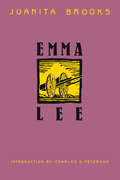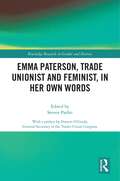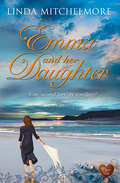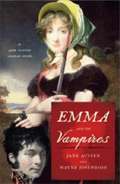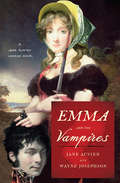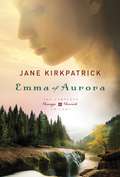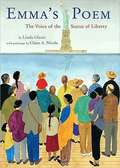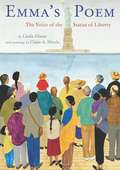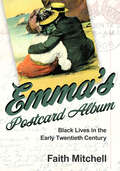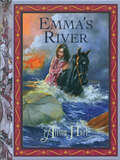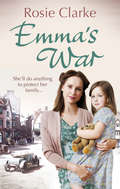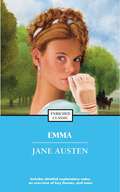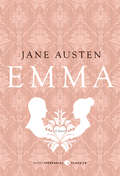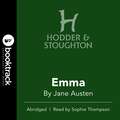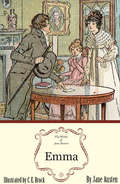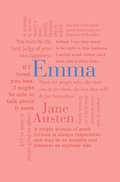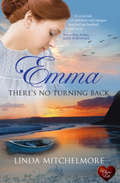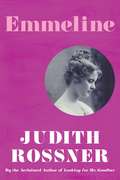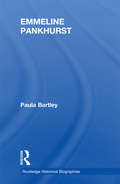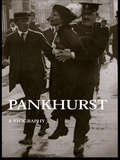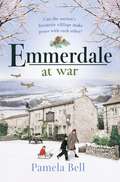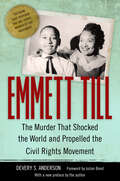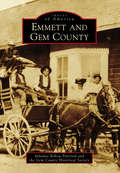- Table View
- List View
Emma Lee
by Juanita BrooksNow in its eighth printing, Emma Lee is the classic biography of one of John D. Lee's plural wives. Emma experienced the best and worst of polygamy and came as near to the Mountain Meadows Massacre as anyone could without participating firsthand.
Emma Paterson, Trade Unionist and Feminist, In Her Own Words (Routledge Research in Gender and History)
by Steven ParfittEmma Paterson was a pioneer of trade unionism for women. In her short life, she set up a League dedicated to that cause, edited a newspaper to publicise it and travelled the UK working for it. Her spoken and written work addressed issues still with us today, from the gender pay gap to domestic labour, and those thankfully consigned to history, such as whether women should be able to vote or find clothes appropriate to industrial work.Emma Paterson, Trade Unionist and Feminist, In Her Own Words brings together the major works that comprise Emma Paterson’s written output, offering a unique insight into the struggles and concerns of women working in the workshops, factories, shops and homes of Britain’s Industrial Revolution. This book includes a long biographical chapter from the editor, a preface from Frances O’Grady, first woman general secretary of the Trades Union Congress, and then an annotated selection of Emma Paterson’s most important works, from her time as a young activist to her last days as an overworked editor and union leader.This book will appeal to scholars and students of the history of Britain, of its women workers, of industrial, labour and publishing history. It addresses broader questions of class and gender, the interconnections that exist between them and the silences that often accompany them.
Emma and Her Daughter
by Linda MitchelmoreAfter the turmoil of WWI, a wealthy widow returns to England—and the man who once stirred her heart. It is 1927 and the wealthy widow Emma Jago is returning from Canada to the windswept coast of Devon. While the Great War has left its mark on the place, and her teenage daughter Fleur can’t understand her nostalgic reveries, Emma remembers when Matthew Caunter waltzed her around the foyer of a now abandoned hotel. But Devon holds more than sweet memories. As Emma works to reclaim her home, an unwelcome visitor threatens to reveal a secret that could turn her new life upside down. Through it all, Matthew is never far from mind, but when he appears in the flesh—and as dashing as ever—she wonders if it is finally their time to be happy, or if it was truly never meant to be. The award-winning author of Emma: There’s No Turning Back, revisits these “lovely” and “warm” characters in this heartfelt historical romance (Sophie Kind).
Emma and the Vampires
by Jane Austen Wayne JosephsonWhat better place than pale England to hide a secret society of gentlemen vampires? In this hilarious retelling of Jane Austen's Emma, screenwriter Wayne Josephson casts Mr. Knightley as one of the most handsome and noble of the gentlemen village vampires. Blithely unaware of their presence, Emma, who imagines she has a special gift for matchmaking, attempts to arrange the affairs of her social circle with delightfully disastrous results. But when her dear friend Harriet Smith declares her love for Mr. Knightley, Emma realizes she's the one who wants to stay up all night with him. Fortunately, Mr. Knightley has been hiding a secret deep within his unbeating heart-his (literal) undying love for her... A brilliant mash-up of Jane Austen and the undead.
Emma and the Vampires
by Wayne JosephsonWhat better place than pale England to hide a secret society of gentlemen vampires? In this hilarious retelling of Jane Austen's Emma, screenwriter Wayne Josephson casts Mr. Knightley as one of the most handsome and noble of the gentlemen village vampires. Blithely unaware of their presence, Emma, who imagines she has a special gift for matchmaking, attempts to arrange the affairs of her social circle with delightfully disastrous results. But when her dear friend Harriet Smith declares her love for Mr. Knightley, Emma realizes she's the one who wants to stay up all night with him. Fortunately, Mr. Knightley has been hiding a secret deep within his unbeating heart—his (literal) undying love for her... A brilliant mash-up of Jane Austen and the undead.
Emma of Aurora: The Complete Change and Cherish Trilogy: A Clearing in the Wild, A Tendering in the Storm, A Mending at the Edge
by Jane KirkpatrickThe Change and Cherish trilogy, based on the true story of Emma Wagner Giesy, now available in one volume: A Clearing in the Wild When Emma's outspoken ways and growing skepticism lead to a clash with the 1850s Bethel, Missouri colony's beloved leader, she finds new opportunities to pursue her dreams of independence. But as she clears a pathway West to her truest and deepest self, she discovers something she never expected: a yearning for the warm embrace of community. A Tendering in the Storm Determined to raise her children on her own terms, Emma suddenly finds herself alone and pregnant with her third child, struggling to keep her family secure in the remote coastal forest of the Washington Territory. As clouds of despair close in, she must decide whether to continue in her own waning strength or to humble herself and accept help from the very people she once so eagerly left behind. A Mending at the Edge As a mother, daughter, sister, and estranged wife, Emma struggles to find her place inside--and outside--the confines of her religious community. Emma reaches out to others on the fringe, searching for healing and purpose. By blending her unique talents with service to others, she creates renewed hope as she weaves together the threads of family, friends, and faith.
Emma's Poem: The Voice of the Statue of Liberty
by Linda GlaserGive me your tired, your poor<P><P> Your huddled masses yearning to breathe free...<P> Who wrote these words? And why?<P> In 1883, Emma Lazarus, deeply moved by an influx of immigrants from Eastern Europe, wrote a sonnet that was to give voice to the Statue of Liberty. Originally a gift from France to celebrate our shared national struggles for liberty, the Statue, thanks to Emma's poem, slowly came to shape our hearts, defining us as a nation that welcomes and gives refuge to those who come to our shores.<P> Jane Addams Children's Book Award Winner
Emma's Poem: The Voice of the Statue of Liberty
by Linda GlaserGive me your tired, your poorYour huddled masses yearning to breathe free...Who wrote these words? And why? In 1883, Emma Lazarus, deeply moved by an influx of immigrants from Eastern Europe, wrote a sonnet that was to give voice to the Statue of Liberty. Originally a gift from France to celebrate our shared national struggles for liberty, the Statue, thanks to Emma's poem, slowly came to shape our hearts, defining us as a nation that welcomes and gives refuge to those who come to our shores. This title has been selected as a Common Core Text Exemplar (Grades 4-5, Poetry)
Emma's Postcard Album: Black Lives in the Early Twentieth Century (Atlantic Migrations and the African Diaspora)
by Faith MitchellBCALA 2023 Outstanding Contribution to Publishing Citation Award winnerThe turn of the twentieth century was an extraordinarily difficult period for African Americans, a time of unchecked lynchings, mob attacks, and rampant Jim Crow segregation. During these bleak years, Emma Crawford, a young African American woman living in Pennsylvania, corresponded by postcard with friends and family members and collected the cards she received from all over the country. Her album—spanning from 1906 to 1910 and analyzed in Emma's Postcard Album—becomes an entry point into a deeply textured understanding of the nuances and complexities of African American lives and the survival strategies that enabled people “to make a way from no way.” As snippets of lived experience, eye-catching visual images, and reflections of historical moments, the cards in the collection become sources for understanding not only African American life, but also broader American history and culture. In Emma's Postcard Album, Faith Mitchell innovatively places the contents of this postcard collection into specific historic and biographical contexts and provides a new interpretation of postcards as life writings, a much-neglected aspect of scholarship. Through these techniques, a riveting world that is far too little known is revealed, and new insights are gained into the perspectives and experience of African Americans. Capping off these contributions, the text is a visual feast, illustrated with arresting images from the Golden Age of postcards as well as newspaper clippings and other archival material.
Emma's River
by Alison HartIn 1852, Emma and her mama board the Sally May for a steamboat journey filled with danger and adventure. When concern over her beloved pony, Licorice Twist, lures ten-year-old Emma below the main deck—a place that she has been forbidden to go—she is shocked by what she encounters. Here is a world completely different than the pampered one above with its comfortable stateroom and fine food. Here livestock and poor immigrants huddle together—underfed, unclean, and exhausted.Soon Emma is making regular trips below, ferrying food to Patrick, an eleven-year-old stowaway who recently emigrated from Ireland. Slowly, Emma and Patrick develop a friendship that spans classes and ship levels. When the boiler explodes and the steamboat begins to sink, Emma must fight her way through the black smoke to find her friends and family. But is it too late?
Emma's War: (Emma Trilogy 2) (Emma Trilogy #2)
by Rosie ClarkeAll she wanted was her husband to come home…Newly married to the caring RAF pilot Jonathan Reece, Emma thinks that life couldn’t be better. But her happiness is short-lived: within months, Jon’s plane is shot down over France and he is declared missing, presumed dead. Alone and with two children to care for, Emma’s first thought is how to support her family. But when she makes a new friend in the American businessman Jack Harvey, she is faced with a difficult decision. Should she take a last chance at happiness?The second book in the ‘Emma’ trilogy – a warm, nostalgic saga, perfect for fans of Katie Flynn(Note: previously published as The Bonds That Break by Linda Sole)
Emma: A Novel: The Original Edition Of 1902 (volume Ii Of Ii) (Enriched Classics)
by Jane AustenENDURING LITERATURE ILLUMINATED BY PRACTICAL SCHOLARSHIP A high-spirited young woman meddles in other peoples' love lives in this classic comedy of errors set in nineteenth-century England. EACH ENRICHED CLASSIC EDITION INCLUDES: A concise introduction that gives readers important background information A chronology of the author's life and work A timeline of significant events that provides the book's historical context An outline of key themes and plot points to help readers form their own interpretations Detailed explanatory notes Critical analysis, including contemporary and modern perspectives on the work Discussion questions to promote lively classroom and book group interaction A list of recommended related books and films to broaden the reader's experience Enriched Classics offer readers affordable editions of great works of literature enhanced by helpful notes and insightful commentary. The scholarship provided in Enriched Classics enables readers to appreciate, understand, and enjoy the world's finest books to their full potential. SERIES EDITED BY CYNTHIA BRANTLEY JOHNSON
Emma: A Novel: The Original Edition Of 1902 (volume Ii Of Ii) (Word Cloud Classics)
by Jane AustenEmma Woodhouse, handsome, clever, and rich…Emma is also overly confident in her abilities as a matchmaker for the residents of Highbury in Jane Austen’s widely beloved classic novel. Although convinced that she herself will never marry, Emma makes finding the perfect partner for her new friend, Harriet Smith, her most pressing project. It is a well-meaning endeavor that leads both women into a complex tangle of intrigues, misunderstandings, and conflicts of affection, especially after several new admirers come to the fore whose sights are maddeningly set on the wrong woman. Matters of the heart are never as simple as they seem.Jane Austen’s charming novel of love, friendship, and social grace is a timeless classic—as fresh, funny, and poignant as it was when first written.
Emma: Booktrack Edition
by Jane AustenJane Austen's enduring tale of romantic entanglement, read by Sophie Thompson and featuring an immersive musical soundtrack to enhance your audiobook listening experience!Emma is considered by many to be Jane Austen's finest work. Its heroine is fascinating, selfish and manipulative, running riot with other people's emotions and relationships. The author employs her greatest skills to bring about Emma's consequent crisis, awakening and happy resolution.Booktrack is an immersive format that pairs traditional audiobook narration and complementary music. The tempo and rhythm of the score are in perfect harmony with the action and characters throughout the audiobook. Gently playing in the background, the music never overpowers or distracts from the narration so that listeners can enjoy every minute. When you purchase this Booktrack edition, you receive the exact narration as the traditional audiobook available, with the addition of music throughout. (P)1996 Hodder & Stoughton Audiobooks and (P)2018 Booktrack Holding Ltd (background soundtrack only)
Emma: The Illustrated Edition
by Jane AustenIn the introduction to this edition of Austen's celebrated novel, Justice (English, U. of Missouri-Columbia) discusses major questions and themes brought up by the novel, touching on Austen's narrative technique, Austen and social class, gender relations during the period, and satire in Emma. The novel itself includes notes. The second part of the book is a collection of correspondence by Austen and her contemporaries, as well as essays on Emma by Austen and other authors from her time period and later, by writers such as Charlotte Bronte and Virginia Woolf. There is background on the customs of the period, and the complete text of the two poems referred to in the novel is provided. The book's final section offers contemporary 20th century criticism from the past 50 years, delving into topics such as sex and social life in Austen's novels, and Emma as subversive of the slave trade. A detailed chronology of Austen's life is included. The author has written other books on 18th-century literature. Annotation ©2012 Book News, Inc. , Portland, OR (booknews. com)
Emma: The Original Edition Of 1901 (Wordsworth Classics)
by Jane Austen“She was one of those who, having once begun, would be always in love.”Best-selling Victorian author Jane Austen has created many memorable female characters, with intriguing Emma Woodhouse being perhaps the most popular. Emma, a matchmaker at heart, is obsessed with love and romance--for others. As for her own love life, she wants nothing of it. She even feels repulsed by the amorous declarations she receives. But as her matchmaking schemes go awry, and her friend Harriet shares her feelings toward a certain friend, Mr. Knightley, Emma soon becomes aware of her own heart’s longings. * This beautiful book comes with luxurious endpapers, a beautiful and stylish heat-burnished cover, and is a convenient 5 x 7 trim size for easy handling. * The classic has sold millions of copies since its first publication. Emma has been one of the most charming coming-of-age love stories for nearly two centuries. About the Word Cloud Classics series:Classic works of literature with a clean, modern aesthetic! Perfect for both old and new literature fans, the Word Cloud Classics series from Canterbury Classics provides a chic and inexpensive introduction to timeless tales. With a higher production value, including heat burnished covers and foil stamping, these eye-catching, easy-to-hold editions are the perfect gift for students and fans of literature everywhere.
Emma: There's No Turning Back
by Linda MitchelmoreThis British historical romance offers “a vivid tale of ambition and intrigue” from the author of Emma and Her Daughter (Kate Furnivall). Devon, England, 1911. Orphaned and scandalized in her hometown, young Emma Le Goff hasn’t had an easy life. Now she and her childhood sweetheart Seth Jago are set to marry, and for the first time in years, Emma is truly happy. But when Seth’s criminal brother breaks out of jail, his sinister presence brings back a troubling past. Meanwhile, Matthew Caunter, the charismatic man who came to Emma’s rescue in her hour of need, has also returned to Devon. Escaping to Canada may be the young couple’s only hope. But for Emma, the thought of leaving Matthew is almost impossible to bear . . . Award-winning author Linda Mitchelmore continues the tale of her “captivating young heroine” introduced in To Turn Full Circle (Margaret Kaine).
Emmanuel Levinas and the Politics of Non-Violence
by Victoria Tahmasebi-BirganiFrench philosopher and Talmudic commentator Emmanuel Levinas (1906-1995) has received considerable attention for his influence on philosophical and religious thought. In this book, Victoria Tahmasebi-Birgani provides the first examination of the applicability of Emmanuel Levinas' work to social and political movements. Investigating his ethics of responsibility and his critique of the Western liberal imagination, Tahmasebi-Birgani advances the moral, political, and philosophical debates on the radical implications of Levinas' work.Emmanuel Levinas and the Politics of Non-Violence is the first book to closely consider the affinity between Levinas' ethical vision and Mohandas Gandhi's radical yet non-violent political struggle. Situating Levinas' insights within a transnational, transcontinental, and global framework, Tahmasebi-Birgani highlights Levinas' continued relevance in an age in which violence is so often resorted to in the name of "justice" and "freedom."
Emmeline
by Judith RossnerFrom the New York Times bestselling author of Looking for Mr. Goodbar—a haunting tale of forbidden love set against the backdrop of the American industrial revolution.This is the story of Emmeline Mosher, who, before her fourteenth birthday, was sent from her home on a farm in Maine to support her family by working in a cotton mill in Massachusetts. So begins the sixth novel by the author of Looking for Mr. Goodbar. But nothing Judith Rossner has written can prepare the reader for this haunting love story of a young girl thrust into one of America’s early industrial towns, then drawn into a love affair for which she is far from ready. In Emmeline, Rossner brings us the intensity, grasp of character, and storytelling ability that have distinguished her novels of modern women.
Emmeline Pankhurst (Routledge Historical Biographies)
by Paula BartleyIn this well-structured, fluent and lively account, Paula Bartley uses new archival material to assess whether Pankhurst should be seen as a heroine or a tyrant, a conservative or a progressive. Emmeline Pankhurst was the most prominent campaigner for the women's right to vote and was transformed into a popular heroine of the early twentieth century. Early in life she was attracted to socialism, she grew into an entrenched and militant suffragette and ended up as a Conservative Party candidate. This new biography examines the guiding principles that underpinned all of Emmeline Pankhurst's actions, and places her achievements within a wider social and political context.
Emmeline Pankhurst: A Biography
by June PurvisEmmeline Pankhurst was perhaps the most influential woman of the twentieth century. Today her name is synonymous with the 'votes for women' campaign and she is remembered as the most brave and inspirational suffrage leader in history. In this absorbing account of her life both before and after the campaign for women's suffrage, June Purvis documents her early political work, her active role within the suffrage movement and her role as a wife and mother within her family.This fascinating full-length biography of Emmeline Pankhurst, the first for nearly seventy years, draws upon new approaches to feminist biography to place her within the context of her family and friends. It is based upon an unrivalled range of primary sources, including personal interviews with her surviving family.
Emmerdale at War: an uplifting and romantic read perfect for nights in (Emmerdale, Book 3)
by Pamela BellThe perfect Christmas gift full of warmth and nostalgia, for fans of ITV's Emmerdale, and readers who love heartwarming and heartbreaking stories set during World War II.Britain is at war once again and the families of Emmerdale are trying their best to cope with a new way of life.Rationing has been introduced across the country, two million more men have been called up for service, and blackouts, evacuees and military training camps have become the norm. In Beckindale, three young women are about to find their lives changed forever...Annie Pearson is working on Emmerdale Farm, while her love, Edward Sugden is at the front line. Lily Dingle has found purpose in joining the ATS, though she may get more than she bargained for. And Meg Warcup, now teaching at the local school, has taken in two children evacuated from Hull. They've adjusted to their new way of life until one day a German plane comes crashing down in the village... and changes everything in the village of Beckindale.The third novel in the Emmerdale series transports us to the Yorkshire Dales in the midst of World War II, exploring the lives of Emmerdale's much-loved families. Will the nation's favourite village overcome adversity to deal with the loves and lives lost?
Emmerdale at War: an uplifting and romantic read perfect for nights in (Emmerdale, Book 3) (Emmerdale)
by Pamela BellThe perfect Christmas gift full of warmth and nostalgia, for fans of ITV's Emmerdale, and readers who love heartwarming and heartbreaking stories set during World War II.Britain is at war once again and the families of Emmerdale are trying their best to cope with a new way of life.Rationing has been introduced across the country, two million more men have been called up for service, and blackouts, evacuees and military training camps have become the norm. In Beckindale, three young women are about to find their lives changed forever...Annie Pearson is working on Emmerdale Farm, while her love, Edward Sugden is at the front line. Lily Dingle has found purpose in joining the ATS, though she may get more than she bargained for. And Meg Warcup, now teaching at the local school, has taken in two children evacuated from Hull. They've adjusted to their new way of life until one day a German plane comes crashing down in the village... and changes everything in the village of Beckindale.The third novel in the Emmerdale series transports us to the Yorkshire Dales in the midst of World War II, exploring the lives of Emmerdale's much-loved families. Will the nation's favourite village overcome adversity to deal with the loves and lives lost?
Emmett Till: The Murder That Shocked the World and Propelled the Civil Rights Movement (Race, Rhetoric, and Media Series)
by Devery S. AndersonEmmett Till: The Murder That Shocked the World and Propelled the Civil Rights Movement offers the first, and as of 2018, only comprehensive account of the 1955 murder, the trial, and the 2004-2007 FBI investigation into the case and Mississippi grand jury decision. By all accounts, it is the definitive account of the case. It tells the story of Emmett Till, the fourteen-year-old African American boy from Chicago brutally lynched for a harmless flirtation at a country store in the Mississippi Delta. Anderson utilizes documents that had never been available to previous researchers, such as the trial transcript, long-hidden depositions by key players in the case, and interviews given by Carolyn Bryant to the FBI in 2004 (her first in fifty years), as well as other recently revealed FBI documents. Anderson also interviewed family members of the accused killers, most of whom agreed to talk for the first time, as well as several journalists who covered the murder trial in 1955. Till's murder and the acquittal of his killers by an all-white jury set off a firestorm of protests that reverberated all over the world and spurred on the civil rights movement. Like no other event in modern history, the death of Emmett Till provoked people all over the United States to seek social change. Anderson's exhaustively researched book was also the basis for the ABC miniseries Women of the Movement, which was written/executive-produced by Marissa Jo Cerar; directed by Gina Prince-Bythewood, Tina Mabry, Julie Dash, and Kasi Lemmons; and executive-produced by Jay-Z, Jay Brown, Tyran “Ty Ty” Smith, Will Smith, James Lassiter, Aaron Kaplan, Dana Honor, Michael Lohmann, Rosanna Grace, Alex Foster, John Powers Middleton, and David Clark. For over six decades the Till story has continued to haunt the South as the lingering injustice of Till's murder and the aftermath altered many lives. Fifty years after the murder, renewed interest in the case led the Justice Department to open an investigation into identifying and possibly prosecuting accomplices of the two men originally tried. Between 2004 and 2005, the Federal Bureau of Investigation conducted the first real probe into the killing and turned up important information that had been lost for decades. Anderson covers the events that led up to this probe in great detail, as well as the investigation itself. This book will stand as the definitive work on Emmett Till for years to come. Incorporating much new information, the book demonstrates how the Emmett Till murder exemplifies the Jim Crow South at its nadir. The author accessed a wealth of new evidence. Anderson made a dozen trips to Mississippi and Chicago over a ten-year period to conduct research and interview witnesses and reporters who covered the trial. In Emmett Till, Anderson corrects the historical record and presents this critical saga in its entirety.
Emmett and Gem County
by Gem County Historical Society Julianne Rekow PetersonThe Payette River and some of its tributaries serve Gem County from border to border. An abundance of water, a mild climate with protected valley floors, and natural vegetation beckoned to those on Placerville's Umatilla Trail. Having reached the ocean, many of those who had not found their utopia were on the move again, looking with an experienced eye for a place to settle with their families. These valleys had blessed the Shoshoni Indians, as well as the fur trappers and enterprising people providing services to early travelers. As communities progressed, the timber industry, railroads, highways, agriculture, horticulture, and ranching matured to meet demand. This growth, with only occasional setbacks, is documented by this collection of photographs.
